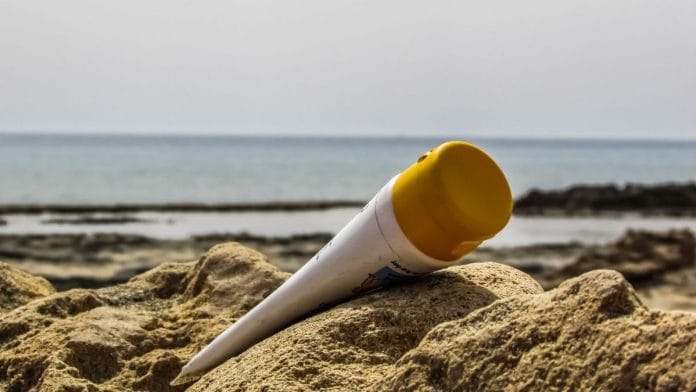Do you think you are safer picking a sunscreen with the highest Sun Protection Factor? If yes, this might be a shocker—a high SPF does not guarantee superior protection from photodamage. If anything, picking sunscreens solely based on their SPF number can prove counterproductive to your sun safety goals.
The sun’s natural energy comprises ultraviolet or UV radiation. UV light has shorter wavelengths than visible on the electromagnetic spectrum, which means your eyes can’t see it, but your skin can feel it. Two forms of UV light have been shown to increase the risk of skin cancer—UVA, which has a longer wavelength and is associated with skin ageing, and UVB, which has a shorter wavelength and is linked to skin burning.
UVB does not penetrate as deeply as UVA, but it can induce DNA mutations in the top layers of your skin, leading to melanoma and other skin cancers. UVA rays are primarily associated with long-term skin damage, such as age spots and wrinkles, and are also believed to be responsible for some skin cancers.
Also read: Marijuana-derived CBD is the new buzzword in skin care — for acne, ageing
What are SPF and PA ratings?
Sun Protection Factor (SPF) is the standard indicator of UVB ray protection. It is a multiplier representing how long it will take to develop a sunburn. For example, SPF 15 indicates that your skin will take 15 times longer to burn. SPF 15 blocks 93 per cent of UVB rays, SPF 30 filters out 97 per cent, and SPF 50 blocks 98 per cent of UVB rays.
Sunburn protection rises with the SPF number. This estimate is affected by skin type, the intensity of sunlight, and the amount of sunscreen applied. But high SPF does not always mean an increase in the duration of protection. Sunscreens with extremely high SPF, such as 75 or 100, may not provide more protection than SPF 30. It would help if you looked at the ‘Protection Grade’ or ‘PA+++’ rating on sunscreen to determine the extent of its UVA protection. More ‘+’ signs mean more protection against sun damage.
Clearly, hunting for the right sunscreen is tricky, especially amid a global surge in skin cancers and a rising awareness of the photodamaging effects of UV radiation. However, this has also enabled increased sunscreen use, which has exhibited favourable results in lowering the symptoms and recurrence of such problems. While the market boasts several ‘broad spectrum’ sunscreens (sun protection creams that protect against both UVA and UVB), their safety and efficacy are being questioned constantly.
SPF ratings and labels are intended to inform and simplify selection. But the variety in sun protection products—from lotions, creams, powders, sticks and sprays—and their different ratings mean consumers are often left confused. Don’t worry; proper application techniques are the answer to all your sun-related woes.
The amount of sunscreen used affects how much solar energy is absorbed into the skin. More sunscreen automatically leads to less absorption. Because sunscreens wear off and become less effective over time, the frequency of reapplication is crucial to reducing UV damage. Squeeze an adequate amount, typically one-and-a-half units of your index finger, and apply all over your face and neck. Any broad-spectrum mineral or chemical sunscreen can protect your skin, albeit you adequately reapply it every two hours.
Also read: Don’t fall for extensive skin care during winter. Fix dryness, dullness with these steps
When to apply
The very first rule of sunscreen application is to do it after following a basic cleansing-toning-moisturising (CTM) regime. This means you wash your face with a mild face wash, followed by a gentle toner, and then dab your face and neck with a sunscreen-blended moisturiser. Then you use eye cream and apply a thick layer of sunscreen to your skin. You may then begin applying makeup, if you use it. It is advisable to apply sunscreen at least 30 minutes before heading out in the sun to achieve maximum UV protection.
This window gives the sunscreen enough time to sink into your skin and not be washed away by sweat. UVB rays are most intense between 11 am and 3 pm, making sun protection essential. As for your body, use a lotion on clean skin, and then dab a generous amount of sunscreen all over.
Furthermore, the activities consumers engage in also influence the frequency of reapplication. For example, those indulging in intense physical activities such as swimming should reapply it more frequently as water can wash sunscreen off their bodies.
Remember to protect yourself in the shade or under bright indoor lights that generate UVA, B or C rays. UV rays may reflect off surfaces such as concrete, water, sand, and snow and still cause considerable photodamage.
Also read: That anti-bacterial facewash you’re using every day is killing your skin. Go probiotic
Mineral, Physical or hybrid sunscreen?
Mineral or physical sunscreens are topical creams that contain zinc oxide or titanium dioxide. These creams form a barrier on top of your skin to block UV rays efficiently.
Chemical sunscreens absorb into your skin, like water into a sponge. They contain chemical filters like avobenzone, octocrylene and oxybenzone, among others. There are a few hybrid sunscreens in the market, too, that mix mineral and chemical filters to provide adequate sun protection. However, if you don’t have hybrid sun creams at your disposal, chemical sunscreen, followed by a layer of physical sunscreen, should suffice.
As I often say, sunscreen is more important than makeup because it makes you appear and feel younger. It should be a part of everyone’s beauty—or, let’s say health—regime.
Dr Deepali Bhardwaj is a dermatologist, anti-allergy specialist, laser surgeon and internationally trained aesthetician. She tweets @dermatdoc. Views are personal.
(Edited by Zoya Bhatti)






